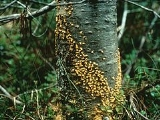
Cronartiaceae
Encyclopedia
Cronartiaceae are a family
of rust fungi
in the order Uredinales.
They are heteroecious
rusts with two alternating hosts, typically a pine
and a flowering plant
, and up to five spore stages. Many of the species are plant disease
s of major economic importance, causing significant damage and (in some cases) heavy mortality in conifers.
Family (biology)
In biological classification, family is* a taxonomic rank. Other well-known ranks are life, domain, kingdom, phylum, class, order, genus, and species, with family fitting between order and genus. As for the other well-known ranks, there is the option of an immediately lower rank, indicated by the...
of rust fungi
Rust (fungus)
Rusts are plant diseases caused by pathogenic fungi of the order Pucciniales. About 7800 species are known. Rusts can affect a variety of plants; leaves, stems, fruits and seeds. Rust is most commonly seen as coloured powder, composed off tiny aeciospores which land on vegetation producing...
in the order Uredinales.
They are heteroecious
Heteroecious
A heteroecious parasite is one that requires at least two hosts. The primary host is the host in which the parasite spends its adult life; the other is the secondary host. Both the primary host and an unrelated alternate host are required for the parasite to complete its life cycle...
rusts with two alternating hosts, typically a pine
Pine
Pines are trees in the genus Pinus ,in the family Pinaceae. They make up the monotypic subfamily Pinoideae. There are about 115 species of pine, although different authorities accept between 105 and 125 species.-Etymology:...
and a flowering plant
Flowering plant
The flowering plants , also known as Angiospermae or Magnoliophyta, are the most diverse group of land plants. Angiosperms are seed-producing plants like the gymnosperms and can be distinguished from the gymnosperms by a series of synapomorphies...
, and up to five spore stages. Many of the species are plant disease
Disease
A disease is an abnormal condition affecting the body of an organism. It is often construed to be a medical condition associated with specific symptoms and signs. It may be caused by external factors, such as infectious disease, or it may be caused by internal dysfunctions, such as autoimmune...
s of major economic importance, causing significant damage and (in some cases) heavy mortality in conifers.

